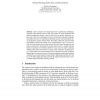Free Online Productivity Tools
i2Speak
i2Symbol
i2OCR
iTex2Img
iWeb2Print
iWeb2Shot
i2Type
iPdf2Split
iPdf2Merge
i2Bopomofo
i2Arabic
i2Style
i2Image
i2PDF
iLatex2Rtf
Sci2ools
EWCBR
2006
Springer
2006
Springer
Unsupervised Feature Selection for Text Data
Feature selection for unsupervised tasks is particularly challenging, especially when dealing with text data. The increase in online documents and email communication creates a need for tools that can operate without the supervision of the user. In this paper we look at novel feature selection techniques that address this need. A distributional similarity measure from information theory is applied to measure feature utility. This utility informs the search for both representative and diverse features in two complementary ways: CLUSTER divides the entire feature space, before then selecting one feature to represent each cluster; and GREEDY increments the feature subset size by a greedily selected feature. In particular we found that GREEDY's local search is suited to learning smaller feature subset sizes while CLUSTER is able to improve the global quality of larger feature sets. Experiments with four email data sets show significant improvement in retrieval accuracy with nearest ne...
Automated Reasoning | EWCBR 2006 | Feature Selection | Feature Selection Techniques | Feature Subset Sizes |
| Added | 22 Aug 2010 |
| Updated | 22 Aug 2010 |
| Type | Conference |
| Year | 2006 |
| Where | EWCBR |
| Authors | Nirmalie Wiratunga, Robert Lothian, Stewart Massie |
Comments (0)

